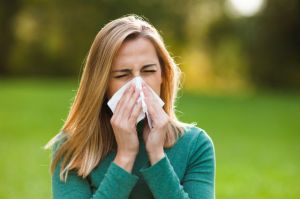When 16-year-old Sophia Falk was in middle school, she had a fantastic opportunity: the chance to play in a soccer tournament in Japan. The young goalkeeper wasn’t thinking about how to travel with food allergies. She’d been diagnosed with a peanut allergy at age 2 but had not had a serious reaction in years. Still, she came out of an early game with trouble breathing.
Just before the game, Sophia had been playing cards with teammates who were having peanuts as a snack. “Either she got something on her hands from playing cards, or it might have been on the goalie gloves,” says Sophia’s mom, Rebecca Haggerty, who was on the trip with her. Benadryl didn’t help, so they used the epinephrine auto-injector Sophia carries, then went to the hospital – fortunately, with the help of a translator the team had hired.
Giving thought to how to travel to a different country, with food allergies, can help travelers avoid allergic reactions. The right tools can also give them the chance to safely enjoy some of the local cuisine.
‘She ate ice cream for three weeks’
James Ahlberg’s daughter has nut allergies, and, as a college student, took a trip to Europe. “I picked her up at the airport, and I said to her, ‘How’d you fare with three weeks with this allergy and unable to speak the language?’ ” Ahlberg said. “And she said mainly she ate ice cream for three weeks.”
These are examples of just one of the challenges those with food allergies face when traveling to other countries: translation. His daughter’s experience led Ahlberg to create SelectWisely, customized cards that travelers can carry with them to help explain a food allergy or other medical condition in the local language.
During his company’s 15 years creating these cards, now offered in more than 60 languages, Ahlberg and his colleagues have learned of lots of idiosyncrasies travelers with allergies might face.
“For example, in the Thai language, they don’t have a word for shellfish, and a lot of people are allergic to shellfish,” Ahlberg said. Some languages don’t have a word for “nuts,” meaning each individual nut must be described. And the word for “peanuts” is different in some Spanish-speaking countries than in others.
Dining out with a food allergy
SelectWisely cards are especially helpful at restaurants.
“It’s very important in restaurant eating to really declare your allergy and to instruct the restaurant a bit,” said Dr. Scott Sicherer, director of the Jaffe Food Allergy Institute at Mount Sinai Medical Center. “You have to be really good at making it clear that it’s an allergy, not just a taste or an intolerance, making it clear that a small amount could make you sick, making it clear that you’re worried about cross-contact and hidden ingredients and giving examples of those.”
For instance, picking the nuts off of a salad doesn’t make that salad safe for someone with a nut allergy and chicken grilled next to a cheeseburger could give someone with a dairy allergy a serious reaction.
A good restaurant strategy for those with food allergies is to order simple ingredients prepared simply, Sicherer said, staying away from sauces and dishes with multiple ingredients.
“If you know you’re not allergic to rice and you’re getting plain rice, you can see that they didn’t put sauce on it,” he said. Or if you want a baked potato, get a plain baked potato to save yourself from having to worry about other questionable ingredients.

So, when is it safe to travel with food allergies? Any time, as long as you are cautious and prepared.
Here are some additional tips on how to travel to a different country with food allergies.
- Review your action plan with your allergist beforehand. Do you need extra EpiPens or other medications? Do you know when to use those medications? “When traveling, you might be more liberal in giving medication to yourself rather than waiting,” Sicherer said.
- Think about where you’ll be staying. Does the hotel staff speak English? Should you bring some prepackaged foods with you? Will your room have a kitchenette where you could prepare allergy-safe food if needed? If you’re taking a cruise, where you’ll be dependent on on-board meals, can the kitchen assure you’ll be safe? Buffets are rife with cross-contact, Sicherer said, so those with food allergies should avoid them.
- Make sure to let others know about your food allergy. Options include medical identification jewelry, though this might not be in the local language. There are also phone apps that will allow others to access essential medical information about you if you are unconscious or otherwise unable to communicate (such as Medical ID in the iPhone Health app or similar downloadable apps for Android devices.) And there are medical translation cards such as SelectWisely. Ahlberg says the company has even had travelers request cards in English because of the sense of authenticity. “They say that presenting that is better than just saying, ‘I can’t eat these foods,’ ” he said.
As with so many aspects of travel, the key to how to travel to a different country with food allergies is in planning ahead. Your allergy does not need to keep you at home, and you don’t have to spend your trip on a single-food diet. Talk with your allergist, gather some tools, and away you go.
Do you have food allergies and does it impact the way you travel? Share your tips for how to travel with food allergies in the comments.

















